- الرئيسية
- معلومات عنا
- صناعة
- الخدمات
- قراءة
- اتصل بنا
سوق تطبيقات تقسيم الفواتير: تحليل وتوقعات حالية (2024-2032)
التركيز على المنصة (Android و iOS)؛ المستخدمون النهائيون (المستخدم الشخصي والمستخدمون التجاريون)؛ والمنطقة/البلد
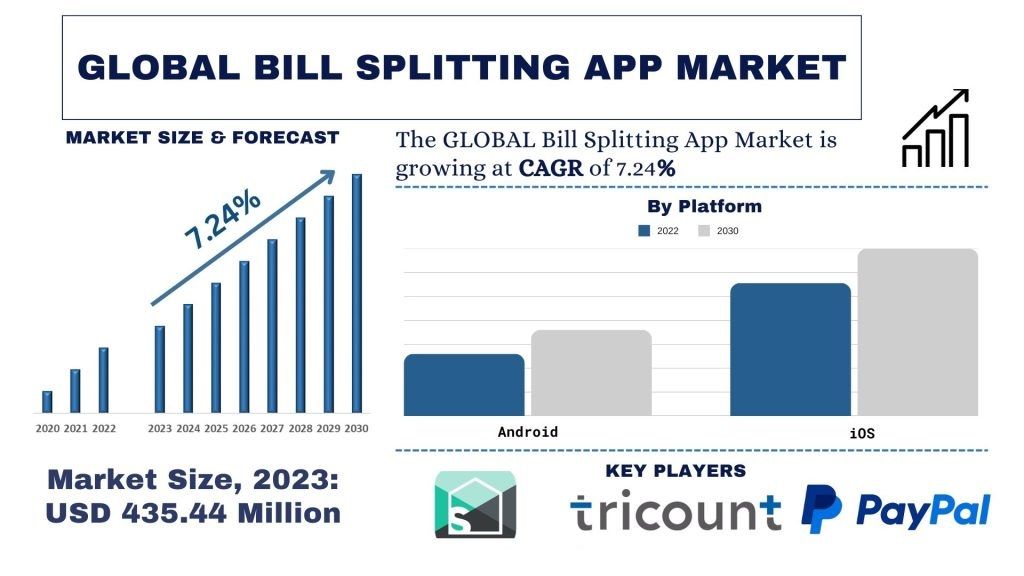
حجم سوق تطبيقات تقسيم الفواتير والتوقعات
تم تقييم سوق تطبيقات تقسيم الفواتير بـ 435.44 مليون دولار أمريكي، ومن المتوقع أن ينمو بمعدل نمو سنوي مركب قوي يبلغ حوالي 7.24% خلال الفترة المتوقعة (2024-2032) نظرًا للاتجاه المتزايد للاقتصاد التشاركي في جميع أنحاء العالم.
تحليل سوق تطبيقات تقسيم الفواتير
تطبيقات تقسيم الفواتير هي تطبيقات جوال مصممة لتبسيط عملية تقسيم وتتبع النفقات المشتركة بين الأصدقاء أو زملاء السكن أو المجموعات. الغرض الأساسي من هذه التطبيقات هو القضاء على متاعب حساب من يدين لمن وما يضمن أن يدفع الجميع نصيبهم العادل. الوظيفة الأساسية لتطبيق تقسيم الفواتير هي إنشاء منصة مركزية حيث يمكن للمستخدمين تسجيل النفقات المشتركة، مثل الإيجار والمرافق والبقالة وفواتير المطاعم أو تكاليف السفر.
أعاد الاقتصاد التشاركي، الذي تسهله منصات مثل Uber و Airbnb، تشكيل سلوك المستهلك. أصبح الناس أكثر ميلاً إلى مشاركة الموارد، بما في ذلك النفقات. علاوة على ذلك، يقود جيل الألفية والجيل Z تحولاً ثقافيًا كبيرًا، مع إعطاء الأولوية للتجارب على الممتلكات المادية. غالبًا ما يشاركون في الأنشطة الاجتماعية والسفر وتناول الطعام بالخارج مع الأصدقاء والزملاء.على سبيل المثال، وفقًا لمنظمة السياحة العالمية، من المتوقع أن يصل عدد السياح الدوليين الوافدين إلى 1.8 مليار بحلول عام 2030، بمعدل نمو سنوي متوسط قدره 3.3% من عام 2020 إلى عام 2030. تقدم تطبيقات تقسيم الفواتير حلاً سلسًا لتوزيع النفقات بالتساوي، لتلبية أنماط حياتهم التعاونية والمهووسة بالتكنولوجيا. بالإضافة إلى ذلك، اندمجت العديد من تطبيقات تقسيم الفواتير مع منصات الدفع الرقمية الشائعة مثل Venmo و PayPal و Apple Pay، مما يوفر للمستخدمين تجربة سلسة. يعزز هذا التكامل وظائف التطبيق ويجعله أكثر جاذبية للمستخدمين الذين هم بالفعل على دراية بحلول الدفع هذه. علاوة على ذلك، تقدم تطبيقات تقسيم الفواتير ميزات مخصصة، مثل فئات المصروفات القابلة للتخصيص، وخيارات التقسيم (متساوية أو غير متساوية)، والتذكيرات بالأرصدة غير المسددة. تساهم هذه الميزات سهلة الاستخدام في تجربة أفضل بشكل عام، وتشجع على الاستخدام والاعتماد المستمر.
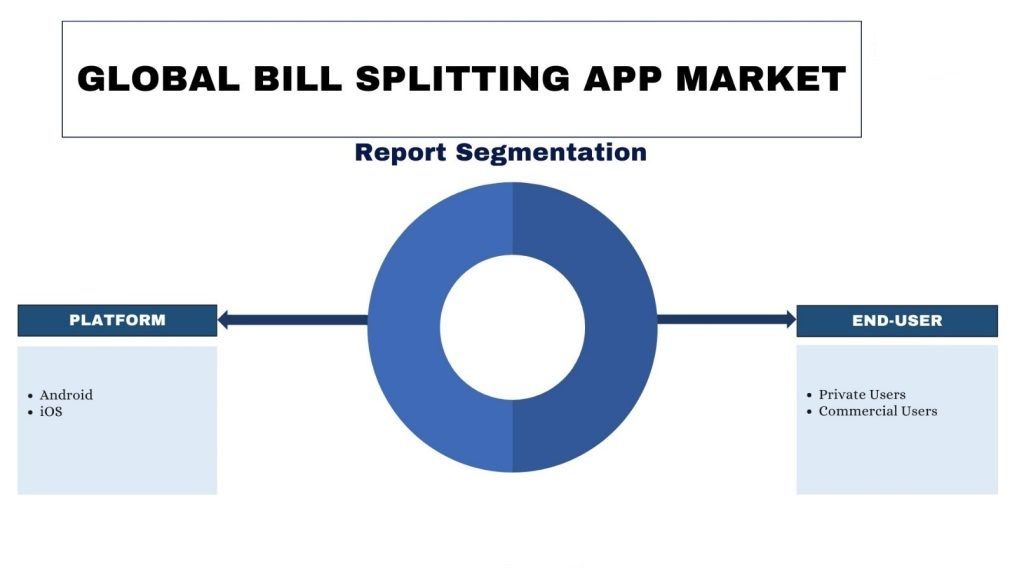
اتجاهات سوق تطبيقات تقسيم الفواتير
يناقش هذا القسم اتجاهات السوق الرئيسية التي تؤثر على القطاعات المختلفة لسوق تطبيقات تقسيم الفواتير، كما حددها فريق خبراء الأبحاث لدينا.
أثبتت منصة Android أنها المستفيد الرئيسي لتطبيقات تقسيم الفواتير من خلال توفير توزيع واسع النطاق للتطبيق على مستوى العالم.
تمتلك منصة Android حاليًا الحصة الأكبر من سوق تطبيقات تقسيم الفواتير وتدر جزءًا كبيرًا من الإيرادات. ويرجع ذلك في المقام الأول إلى الانتشار الواسع لهواتف Android الذكية. Android هو نظام تشغيل الأجهزة المحمولة الأكثر استخدامًا على مستوى العالم، بحصة سوقية تبلغ حوالي 70%. توفر قاعدة المستخدمين الواسعة هذه سوقًا محتملاً أكبر لتطبيقات تقسيم الفواتير على نظام Android الأساسي، مما يترجم إلى توليد إيرادات أعلى. علاوة على ذلك، تكون هواتف Android الذكية بشكل عام ميسورة التكلفة أكثر من نظيراتها من iOS، مما يجعلها في متناول مجموعة أوسع من المستخدمين، بمن فيهم أولئك الموجودون في الأسواق الناشئة. يساهم عامل إمكانية الوصول هذا في زيادة اعتماد تطبيقات تقسيم الفواتير على نظام Android الأساسي. تتيح بنية Android مفتوحة المصدر أيضًا تخصيصًا ومرونة أكبر في تطوير التطبيقات. يمكن للمطورين بسهولة دمج وظائف تقسيم الفواتير في التطبيقات الموجودة أو إنشاء تطبيقات مخصصة مصممة خصيصًا لتلبية احتياجات المستخدمين المحددة، مما يؤدي إلى زيادة الاعتماد والإيرادات. أخيرًا، بالإضافة إلى متجر Google Play الرسمي، يمكن لمستخدمي Android الوصول إلى التطبيقات وتثبيتها من متاجر ومصادر تطبيقات أخرى تابعة لجهات خارجية. يعمل نظام التوزيع المتنوع هذا على زيادة إمكانية اكتشاف تطبيقات تقسيم الفواتير والوصول إليها، مما يساهم في نموها على نظام Android الأساسي. إن عوامل مثل هذه تعمل على تعزيز بيئة مواتية، مما يؤدي إلى نمو في اعتماد تطبيقات تقسيم الفواتير على منصات android.
تتصدر أمريكا الشمالية كأكبر سوق لتطبيقات تقسيم الفواتير في جميع أنحاء العالم.
داخل أمريكا الشمالية، تحتل الولايات المتحدة الأمريكية الجزء الأكبر من سوق تطبيقات تقسيم الفواتير في أمريكا الشمالية. العامل الرئيسي الذي يعزز نمو السوق هو موقعها القيادي العالمي في صناعة التكنولوجيا. علاوة على ذلك، تعد الولايات المتحدة الأمريكية موطنًا لأكبر نظام بيئي للخدمات المصرفية الرقمية. لقد ساهم دمج هذه الخدمات في تطبيقات تقسيم الفواتير بشكل كبير في الاعتماد الواسع النطاق لتطبيقات تقسيم الفواتير في أسواق الولايات المتحدة.
تحتل أمريكا الشمالية، وخاصة الولايات المتحدة، الحصة الأكبر من سوق تطبيقات تقسيم الفواتير وتبرز كأكبر جهة معتمدة لهذه التطبيقات. تساهم عدة عوامل في هذا الاعتماد الواسع النطاق. تتمتع أمريكا الشمالية، وخاصة الولايات المتحدة، بمستوى عالٍ من التقدم التكنولوجي وانتشار استخدام الهواتف الذكية على نطاق واسع. يسهل معدل انتشار الهواتف الذكية المرتفع هذا اعتماد تطبيقات الجوال، بما في ذلك تطبيقات تقسيم الفواتير. علاوة على ذلك، تعد ثقافة تناول الطعام السائدة في أمريكا الشمالية عاملاً رئيسيًا يدفع نمو تطبيقات تقسيم الفواتير.على سبيل المثال، في فبراير 2024، وفقًا للتقرير الصادر عن الرابطة الوطنية للمطاعم في الولايات المتحدة الأمريكية، من المتوقع أن تتجاوز مبيعات صناعة المطاعم تريليون دولار أمريكي للمرة الأولى، بينما من المتوقع أن تزيد ثاني أكبر جهة توظيف في القطاع الخاص في البلاد قوتها العاملة بمقدار 200000، ليصل إجمالي التوظيف إلى 15.7 مليون فرد. تخلق ثقافة تناول الطعام المزدهرة هذه طلبًا على حلول الدفع المريحة، مثل تطبيقات تقسيم الفواتير، والتي تبسط عملية تقسيم الفواتير بين الأصدقاء أو الزملاء. بالإضافة إلى ذلك، شهدت أمريكا تحولًا كبيرًا نحو المدفوعات غير النقدية، مدفوعًا بالاعتماد الواسع النطاق لبطاقات الائتمان/الخصم وحلول الدفع عبر الهاتف المحمول. يتماشى اتجاه الدفع غير النقدي هذا مع استخدام تطبيقات تقسيم الفواتير، والتي غالبًا ما تتكامل مع منصات الدفع عبر الهاتف المحمول. هذه بعض العوامل التي تعزز سيناريو النمو المرتفع وتؤثر على الاعتماد الواسع النطاق لتطبيقات تقسيم الفواتير في أمريكا الشمالية.
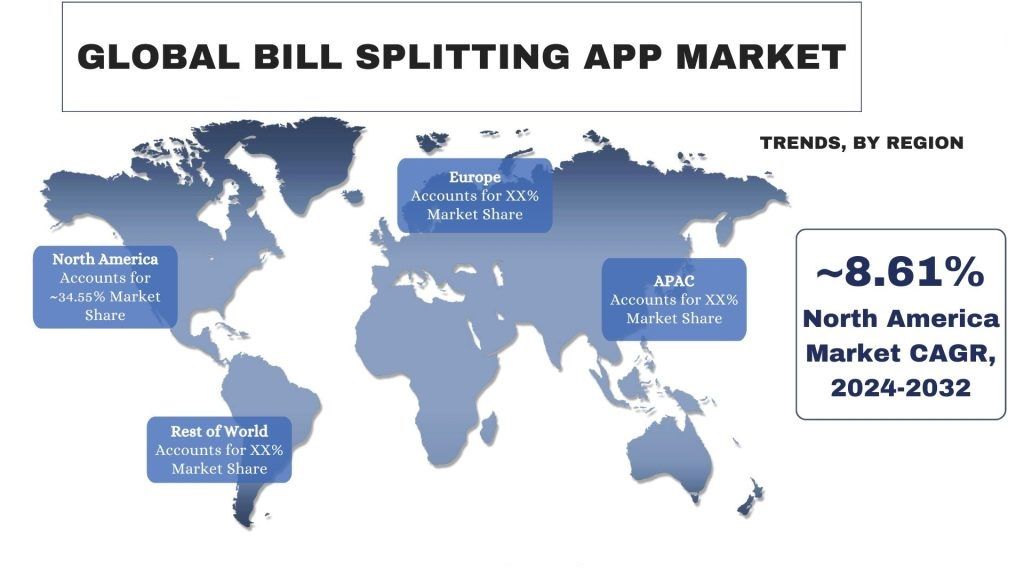
نظرة عامة على صناعة تطبيقات تقسيم الفواتير
سوق تطبيقات تقسيم الفواتير تنافسي ومتجزئ، مع وجود العديد من اللاعبين العالميين والدوليين في السوق. يعتمد اللاعبون الرئيسيون استراتيجيات نمو مختلفة لتعزيز وجودهم في السوق، مثل الشراكات والاتفاقيات والتعاون وإطلاق المنتجات الجديدة والتوسعات الجغرافية وعمليات الاندماج والاستحواذ. بعض اللاعبين الرئيسيين العاملين في السوق هم Splitwise و Tricount و PayPal, Inc. و Block, Inc. و Apple Inc. و bring10, LLC. و Step Up Labs, Inc. و Split و Bilr و BillBuddy.
أخبار سوق تطبيقات تقسيم الفواتير
- في نوفمبر 2023، قدمت Venmo، وهي شركة مملوكة لـ PayPal، ميزات جديدة تمكن المستخدمين من مراقبة وإدارة النفقات المختلفة داخل المجموعات مثل العائلات وزملاء الغرفة والنوادي والفرق الرياضية والمنظمات المجتمعية والمزيد. من خلال مجموعات Venmo، يمكن للمستخدمين تتبع النفقات المستمرة وتقسيمها وإدارتها وتسويتها بسهولة مباشرةً داخل تطبيق Venmo.
- في أغسطس 2023، وجد تقرير صادر عن Nikkei Asia أن المستهلكين من الجيل Z يعطون الأولوية للأمن وتجنب الإفراط في الإنفاق. إنهم حذرون بشأن اقتراض الأموال من الأصدقاء ويفضلون الخدمات التي تساعد في تقسيم الفواتير بشكل عادل، مثل Walica في اليابان. وفقًا لمسح أجرته SMBC Consumer Finance، يشعر 37.2% من المشاركين في الجيل Z بعدم الارتياح لدفع ثمن الآخرين، بينما يشعر 25.5% بعدم الارتياح لأن يدفع الآخرون لهم. يستخدم Walica بشكل شائع لتسوية النفقات المتعلقة برحلات المجموعة والتجمعات الاجتماعية، ودعم أكثر من 60 عملة.
تغطية تقرير سوق تطبيقات تقسيم الفواتير
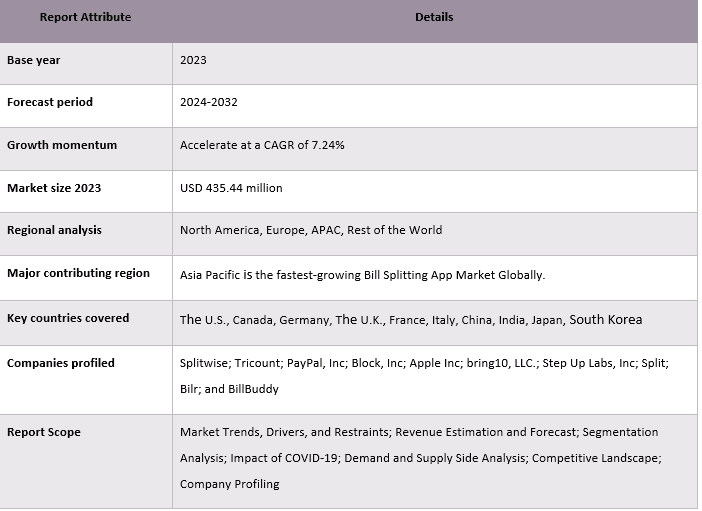
تغطية تقرير سوق تطبيقات تقسيم الفواتير أسباب شراء هذا التقرير:
- تتضمن الدراسة تحديد حجم السوق وتحليل التنبؤات التي تم التحقق منها من قبل خبراء الصناعة الرئيسيين المعتمدين.
- يقدم التقرير مراجعة سريعة للأداء العام للصناعة في لمحة.
- يغطي التقرير تحليلًا متعمقًا لنظرائه البارزين في الصناعة مع التركيز الأساسي على البيانات المالية التجارية الرئيسية ومحافظ المنتجات واستراتيجيات التوسع والتطورات الأخيرة.
- فحص مفصل للمحركات والقيود والاتجاهات الرئيسية والفرص السائدة في الصناعة.
- تغطي الدراسة السوق بشكل شامل عبر شرائح مختلفة.
- تحليل متعمق على المستوى الإقليمي للصناعة.
خيارات التخصيص:يمكن تخصيص سوق تطبيقات تقسيم الفواتير العالمي بشكل أكبر وفقًا للمتطلبات أو أي قطاع سوق آخر. إلى جانب ذلك، تفهم UMI أنه قد تكون لديك احتياجات عملك الخاصة؛ وبالتالي، لا تتردد في الاتصال بنا للحصول على تقرير يناسب متطلباتك تمامًا.

يمكنك أيضًا شراء أجزاء من هذا التقرير. هل تريد الاطلاع على قسم
قائمة الأسعار الحكيمة؟
جدول المحتويات
منهجية البحث لتحليل سوق تطبيقات تقسيم الفواتير (2024-2032)
كانت الخطوات الثلاث الرئيسية التي تم اتخاذها لإنشاء وتحليل اعتماد تطبيقات تقسيم الفواتير في المناطق الرئيسية على مستوى العالم هي تحليل السوق التاريخي وتقدير السوق الحالي والتنبؤ بالسوق المستقبلية لسوق تطبيقات تقسيم الفواتير العالمي. تم إجراء بحث ثانوي شامل لجمع أرقام السوق التاريخية وتقدير حجم السوق الحالي. ثانيًا، للتحقق من صحة هذه الرؤى، تم أخذ العديد من النتائج والافتراضات في الاعتبار. علاوة على ذلك، تم إجراء مقابلات أولية شاملة أيضًا مع خبراء الصناعة عبر سلسلة القيمة لسوق تطبيقات تقسيم الفواتير العالمي. بعد افتراض أرقام السوق والتحقق منها من خلال المقابلات الأولية، استخدمنا نهجًا تصاعديًا/هابطًا للتنبؤ بحجم السوق الكامل. بعد ذلك، تم اعتماد طرق تقسيم السوق وتثليث البيانات لتقدير وتحليل حجم السوق للقطاعات والقطاعات الفرعية للصناعة ذات الصلة. يتم شرح المنهجية التفصيلية أدناه:
تحليل حجم السوق التاريخي
الخطوة 1: دراسة متعمقة للمصادر الثانوية:
أجريت دراسة ثانوية مفصلة للحصول على حجم السوق التاريخي لسوق تطبيقات تقسيم الفواتير من خلال مصادر داخلية للشركة مثلالتقارير السنوية والبيانات المالية وعروض الأداء والبيانات الصحفية وما إلى ذلك،و مصادر خارجية تشملالمجلات والأخبار والمقالات والمنشورات الحكومية ومنشورات المنافسين وتقارير القطاع وقاعدة بيانات الطرف الثالث والمنشورات الموثوقة الأخرى.
الخطوة 2: تقسيم السوق:
بعد الحصول على حجم السوق التاريخي لسوق تطبيقات تقسيم الفواتير، أجرينا تحليلاً ثانويًا تفصيليًا لجمع رؤى السوق التاريخية والحصة للشرائح والشرائح الفرعية المختلفة للمناطق الرئيسية. يتم تضمين الشرائح الرئيسية في التقرير كمنصة ومستخدم نهائي. علاوة على ذلك، تم إجراء تحليلات على مستوى الدولة لتقييم الاعتماد العام لنماذج الاختبار في تلك المنطقة.
الخطوة 3: تحليل العوامل:
بعد الحصول على حجم السوق التاريخي للشرائح والشرائح الفرعية المختلفة، أجرينا تحليلًا تفصيليًاتحليل العوامللتقدير حجم السوق الحالي لسوق تطبيقات تقسيم الفواتير. علاوة على ذلك، أجرينا تحليل العوامل باستخدام متغيرات تابعة ومستقلة مثل النظام الأساسي والمستخدم النهائي لسوق تطبيقات تقسيم الفواتير. تم إجراء تحليل شامل لسيناريوهات العرض والطلب مع الأخذ في الاعتبار الشراكات الكبرى وعمليات الاندماج والاستحواذ والتوسع في الأعمال وإطلاق المنتجات في قطاع سوق تطبيقات تقسيم الفواتير في جميع أنحاء العالم.
تقدير وتوقعات حجم السوق الحالي
تحديد الحجم الحالي للسوق:بناءً على رؤى قابلة للتنفيذ من الخطوات الثلاث المذكورة أعلاه، توصلنا إلى حجم السوق الحالي، واللاعبين الرئيسيين في سوق تطبيقات تقسيم الفواتير العالمية، وحصص السوق للشرائح. تم تحديد جميع حصص النسب المئوية المطلوبة والانقسامات وانهيارات السوق باستخدام النهج الثانوي المذكور أعلاه وتم التحقق منها من خلال المقابلات الأولية.
التقدير والتنبؤ:لتقدير السوق والتنبؤ به، تم تخصيص أوزان لعوامل مختلفة بما في ذلك المحركات والاتجاهات والقيود والفرص المتاحة لأصحاب المصلحة. بعد تحليل هذه العوامل، تم تطبيق تقنيات التنبؤ ذات الصلة، أي النهج التصاعدي / التنازلي، للوصول إلى توقعات السوق لعام 2032 لشرائح وشرائح فرعية مختلفة عبر الأسواق الرئيسية على مستوى العالم. تشمل منهجية البحث المعتمدة لتقدير حجم السوق:
- حجم سوق الصناعة، من حيث الإيرادات (دولار أمريكي) ومعدل اعتماد سوق تطبيقات تقسيم الفواتير عبر الأسواق الرئيسية محليًا
- جميع حصص النسب المئوية والانقسامات وانهيارات قطاعات السوق والقطاعات الفرعية
- اللاعبين الرئيسيين في سوق تطبيقات تقسيم الفواتير العالمية من حيث المنتجات المعروضة. أيضًا، استراتيجيات النمو التي اعتمدها هؤلاء اللاعبون للتنافس في السوق سريعة النمو.
التحقق من حجم السوق وحصته
البحث الأساسي:أُجريت مقابلات متعمقة مع قادة الرأي الرئيسيين (KOLs) بما في ذلك كبار المديرين التنفيذيين (CXO / VPs ورئيس المبيعات ورئيس التسويق والرئيس التشغيلي والرئيس الإقليمي ورئيس الدولة وما إلى ذلك) عبر مناطق مهمة. ثم تم تلخيص نتائج البحوث الأولية، وإجراء التحليل الإحصائي لإثبات الفرضية المذكورة. تم دمج مدخلات البحث الأساسية مع النتائج الثانوية، وبالتالي تحويل المعلومات إلى رؤى قابلة للتنفيذ.
تقسيم المشاركين الأساسيين في مناطق مختلفة
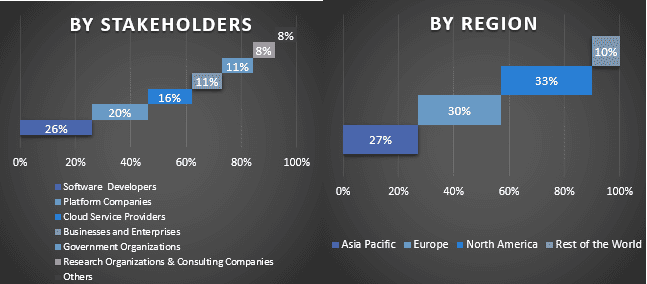
هندسة السوق
تم استخدام تقنية تثليث البيانات لإكمال التقدير العام للسوق والتوصل إلى أرقام إحصائية دقيقة لكل شريحة وشريحة فرعية من بيانات سوق تطبيقات تقسيم الفواتير العالمية، تم تقسيم البيانات إلى عدة شرائح وشرائح فرعية بعد دراسة المعلمات والاتجاهات المختلفة في مجالات المنصة والمستخدم النهائي في سوق تطبيقات تقسيم الفواتير العالمية.
الهدف الرئيسي من دراسة سوق تطبيقات تقسيم الفواتير العالمية
تم تحديد اتجاهات السوق الحالية والمستقبلية لسوق تطبيقات تقسيم الفواتير العالمية في الدراسة. يمكن للمستثمرين الحصول على رؤى استراتيجية لتأسيس تقديرهم للاستثمارات على التحليل النوعي والكمي الذي تم إجراؤه في الدراسة. تشمل الأهداف الكمية الأخرى للدراسات:
- تحليل حجم السوق الحالي والمتوقع لسوق تطبيقات تقسيم الفواتير من حيث القيمة (بالدولار الأمريكي). أيضًا، تحليل حجم السوق الحالي والمتوقع للشرائح والشرائح الفرعية المختلفة.
- تشمل الشرائح في الدراسة مجالات النظام الأساسي والمستخدم النهائي.
- تحديد وتحليل الإطار التنظيمي لتطبيق تقسيم الفواتير
- تحليل سلسلة القيمة المتضمنة في وجود مختلف الوسطاء، إلى جانب تحليل سلوكيات العملاء والمنافسين في الصناعة
- تحليل حجم السوق الحالي والمتوقع لسوق تطبيقات تقسيم الفواتير للمنطقة الرئيسية
- تشمل الدول الرئيسية في المناطق التي تمت دراستها في التقرير منطقة آسيا والمحيط الهادئ وأوروبا وأمريكا الشمالية وبقية العالم
- ملفات تعريف الشركة الخاصة بسوق تطبيقات تقسيم الفواتير واستراتيجيات النمو التي اعتمدها اللاعبون في السوق للحفاظ على استمرارهم في السوق سريع النمو.
- تحليل متعمق على المستوى الإقليمي للصناعة
الأسئلة الشائعة الأسئلة الشائعة
س1: ما هو حجم السوق الحالي وإمكانات النمو لسوق تطبيقات تقسيم الفواتير العالمي؟
س2: ما هي العوامل الدافعة لنمو سوق تطبيقات تقسيم الفواتير العالمي؟
س4: ما هي التقنيات والاتجاهات الناشئة في سوق تطبيقات تقسيم الفواتير العالمي؟
س5: أي منطقة ستكون أسرع الأسواق نموًا لتطبيقات تقسيم الفواتير العالمية؟
س6: من هم اللاعبون الرئيسيون في سوق تطبيقات تقسيم الفواتير العالمي؟
ذات صلة التقارير
العملاء الذين اشتروا هذا المنتج اشتروا أيضًا










